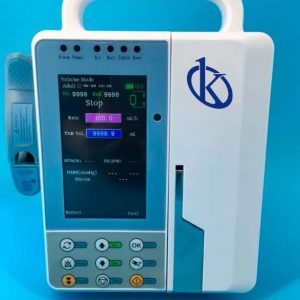Infusion pumps are machines designed to ensure and control medical procedures at intravenous level in patients who require it, which generally control low risk where greater accuracy and reliability is required.
These devices control the infusion, allowing the passage of medications depending on the height of the container of liquid to the patient
Systems of use of Infusion Pumps
Infusion pumps are used because of their availability to administer medicines at high pressures, which cannot be subjected to manually manipulated or dependent devices that compromise the patient, such as during the administration of vital drugs, or very fast flows of solutions during resuscitation (200-1000 ml/h).
In high-risk situations where greater accuracy and reliability are required, an infusion pump should be used. These systems can be classified into:
- Drip controller: this defines the desired flow in drops per minute. A droplet sensor located in the drip chamber and counts the droplets where it clogs the infusion line to keep the flow defined.
- Volumetric controller: it has to do with the flow in milliliters per hour. The controller has a droplet sensor in the drip chamber and performs a drop-per-minute to milliliter-per-hour conversion. The controller closes the infusion line while maintaining the desired flow.
Types of Infusion Pumps
- Infusion Pump to Syringe. The syringe infusion pump delivers the medication in small volumes (1 to 60 mL) of liquids into the patient via one or more syringes. The flow rate is defined by the patient and generally the pump requires the insertion of the type of syringe to be used.
- Positive Displacement Pumps: they serve the performance of the pumping mechanism, either with alternative or rotating motion, to give the passage from the entrance to the pump outlet.
- The Cassette Bombs: It works by means of a camera to monitor fluid movement of the liquid by the action of one or more pistons. This mechanism moves a portion of a milliliter of fluid to the patient who requires it, internally and externally, directing the flow to the pathway and at the appropriate time in the pumping cycle.
- Peristaltic Linear Pump: these can be used to make way for a variety of fluids, supported by the capacity of a flexible plastic conductor that allows the passage of them. It is also attached to the mechanism by finger-shaped disks that press the tube, forcing the liquid out of the patient’s container, in order to offer similar levels of accuracy to the previous one.
- Rotary Peristaltic Pump: It is operated by rollers that press the liquid into the tube by semi-circular motions, depending on the size of the camera, the tube, the speed of rotation, designed for a certain equipment. It is also used for blood infusion in the operating room, during bypass placement or separation of plasma cells in case the patient requires it.
Models of Infusion Pumps in KALSTEIN
At Kalstein we are manufacturers of medical equipment at the best prices in the market, and have innovative designs with the highest technology. So we offer you and the new infusion pump, YR model, from our page https://kalstein.net/en/ who has the following characteristics:
- 4.3-inch color LCD display with backlight suitable for working in various ambient light conditions.
- Infusion monitoring system (optional), the status of each pump is displayed in real time at the central station via wireless transmission.
- Displays the time, battery, infusion status, mode, speed, target volume, accumulated volume, target volume, sound volume, pressure, department, bed number, temperature of the drug.
- They allow for greater accuracy in drip rate than gravity systems via a flow-regulating clamp. HERE
For more information about our infusion pumps, we invite you to take a look at HERE

